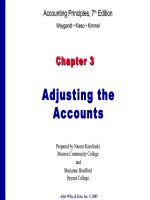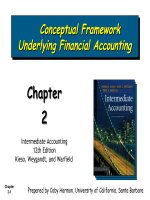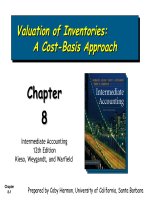Intermediate accounting 12th edition kieso warfield chapter 03
Bạn đang xem bản rút gọn của tài liệu. Xem và tải ngay bản đầy đủ của tài liệu tại đây (337.28 KB, 55 trang )
The
The Accounting
Accounting Information
Information
System
System
Chapter
3
Intermediate Accounting
12th Edition
Kieso, Weygandt, and Warfield
Chapter
3-1
Prepared by Coby Harmon, University of California, Santa Barbara
Learning
Learning Objectives
Objectives
1.
Understand basic accounting terminology.
2.
Explain double-entry rules.
3.
Identify steps in the accounting cycle.
4.
Record transactions in journals, post to ledger accounts,
and prepare a trial balance.
5.
Explain the reasons for preparing adjusting entries.
6.
Prepare financial statement from the adjusted trial
balance.
7.
Prepare closing entries.
8.
Explain how to adjust inventory accounts at year-end.
Chapter
3-2
Accounting
Accounting Information
Information System
System
Accounting
AccountingInformation
Information
System
System
The
TheAccounting
AccountingCycle
Cycle
Basic terminology
Debits and credits
Identification and recording
Journalizing
Basic equation
Financial statements and
ownership structure
Posting
Trial balance
Adjusting entries
Adjusted trial balance
Preparing financial
statements
Closing
Post-closing trial balance
Reversing entries
Chapter
3-3
Financial statements for
merchandisers
Accounting
Accounting Information
Information System
System
An Accounting Information System (AIS)
collects and processes transaction data and
disseminates the information to interested
parties.
Chapter
3-4
Accounting
Accounting Information
Information System
System
Helps management answer such questions as:
How much and what kind of debt is outstanding?
Were sales higher this period than last?
What assets do we have?
What were our cash inflows and outflows?
Did we make a profit last period?
Chapter
3-5
LO 1 Identify the major financial statements and other means of financial reporting ..
Basic
Basic Terminology
Terminology
Event
Transaction
Account
Real Account
Nominal Account
Ledger
Chapter
3-6
Journal
Posting
Trial Balance
Adjusting Entries
Financial Statements
Closing Entries
LO 1 Understand basic accounting terminology.
Debits
Debits and
and Credits
Credits
An Account shows the effect of transactions on a
given asset, liability, equity, revenue, or expense
account.
Double-entry accounting system (two-sided
effect).
Recording done by debiting at least one account and
crediting another.
DEBITS must equal CREDITS.
Chapter
3-7
LO 2 Explain double-entry rules.
Debits
Debits and
and Credits
Credits
Account
An arrangement that shows
the effect of transactions on
an account.
Debit = “Left”
Credit = “Right”
An Account can
be illustrated in a
T-Account
form.
Chapter
3-8
Account Name
Debit / Dr.
Credit / Cr.
LO 2 Explain double-entry rules.
Debits
Debits and
and Credits
Credits
If Debit entries are greater than Credit entries,
the account will have a debit balance.
Account Name
Debit / Dr.
Transaction #1
$10,000
Transaction #3
8,000
Balance
Chapter
3-9
Credit / Cr.
$3,000
Transaction #2
$15,000
LO 2 Explain double-entry rules.
Debits
Debits and
and Credits
Credits
If Credit entries are greater than Debit entries,
the account will have a credit balance.
Account Name
Debit / Dr.
Transaction #1
Balance
Chapter
3-10
$10,000
Credit / Cr.
$3,000
Transaction #2
8,000
Transaction #3
$1,000
LO 2 Explain double-entry rules.
Debits
Debits and
and Credits
Credits Summary
Summary
Normal
Normal
Balance
Balance
Debit
Debit
Debit / Dr.
Normal
Normal
Balance
Balance
Credit
Credit
Assets
Credit / Cr.
Normal Balance
Chapter
3-24
Equity
Credit / Cr.
Debit / Dr.
Liabilities
Debit / Dr.
Credit / Cr.
Normal Balance
Normal Balance
Chapter
3-23
Expense
Debit / Dr.
Revenue
Chapter
3-25
Credit / Cr.
Debit / Dr.
Normal Balance
Chapter
3-27
Chapter
3-11
Credit / Cr.
Normal Balance
Chapter
3-26
LO 2 Explain double-entry rules.
Debits
Debits and
and Credits
Credits Summary
Summary
Balance Sheet
Income Statement
Asset = Liability + Equity
Revenue - Expense =
Debit
Credit
Chapter
3-12
LO 2 Explain double-entry rules.
Basic
Basic Accounting
Accounting Equation
Equation
Relationship among the assets, liabilities and
stockholders’ equity of a business:
Illustration 3-3
The equation must be in balance after every transaction.
For every Debit there must be a Credit.
Chapter
3-13
LO 2 Explain double-entry rules.
Double-Entry
Double-Entry System
System Exercise
Exercise
1. Invested $32,000 cash and equipment valued at
$14,000 in the business.
Assets
+ 32,000
=
Liabilities
+
Stockholders’
Stockholders’
Equity
Equity
+ 46,000
+ 14,000
Chapter
3-14
LO 2 Explain double-entry rules.
Double-Entry
Double-Entry System
System Exercise
Exercise
2. Paid office rent of $600 for the month.
Assets
- 600
Chapter
3-15
=
Liabilities
+
Stockholders’
Stockholders’
Equity
Equity
- 600
(expense)
LO 2 Explain double-entry rules.
Double-Entry
Double-Entry System
System Exercise
Exercise
3. Received $3,200 advance on a management
consulting engagement.
Assets
+ 3,200
Chapter
3-16
=
Liabilities
+
Stockholders’
Stockholders’
Equity
Equity
+ 3,200
LO 2 Explain double-entry rules.
Double-Entry
Double-Entry System
System Exercise
Exercise
4. Received cash of $2,300 for services completed
for Shuler Co.
Assets
+ 2,300
Chapter
3-17
=
Liabilities
+
Stockholders’
Stockholders’
Equity
Equity
+ 2,300
(revenue)
LO 2 Explain double-entry rules.
Double-Entry
Double-Entry System
System Exercise
Exercise
5. Purchased a computer for $6,100.
Assets
=
Liabilities
+
Stockholders’
Stockholders’
Equity
Equity
+ 6,100
- 6,100
Chapter
3-18
LO 2 Explain double-entry rules.
Double-Entry
Double-Entry System
System Exercise
Exercise
6. Paid off liabilities of $7,000.
Assets
- 7,000
Chapter
3-19
=
Liabilities
+
Stockholders’
Stockholders’
Equity
Equity
- 7,000
LO 2 Explain double-entry rules.
Double-Entry
Double-Entry System
System Exercise
Exercise
7. Declared a cash dividend of $10,000.
Assets
=
Liabilities
+ 10,000
+
Stockholders’
Stockholders’
Equity
Equity
- 10,000
Note
Notethat
thatthe
theaccounting
accountingequation
equationequality
equalityisis
maintained
maintainedafter
afterrecording
recordingeach
eachtransaction.
transaction.
Chapter
3-20
LO 2 Explain double-entry rules.
Ownership
Ownership Structure
Structure
Ownership structure dictates the types of accounts
that are part of the equity section.
Proprietorship
Proprietorship
or
or
Partnership
Partnership
Chapter
3-21
Corporation
Corporation
Capital Account
Common Stock
Drawing Account
Additional Paid-in
Capital
Dividends Declared
Retained Earnings
LO 2 Explain double-entry rules.
Corporation
Corporation Ownership
Ownership Structure
Structure
Illustration 3-4
Balance Sheet
Stockholders’ Equity
Common
Common Stock
Stock
(Investment
(Investment
by
by stockholders)
stockholders)
Dividends
Retained
Retained Earnings
Earnings
(Net
(Net income
income retained
retained in
in business)
business)
Net income or Net loss
(Revenues
(Revenues less
less expenses)
expenses)
Income
Income Statement
Statement
Statement of Retained Earnings
Chapter
3-22
LO 2 Explain double-entry rules.
The
The Accounting
Accounting Cycle
Cycle
Illustration 3-6
Transactions
9. Reversing entries
1. Journalization
8. Post-closing trail balance
2. Posting
7. Closing entries
3. Trial balance
6. Financial Statements
Work
Sheet
4. Adjustments
5. Adjusted trial balance
Chapter
3-23
LO 3 Identify steps in the accounting cycle.
Transactions
Transactions and
and Events
Events
What to Record?
FASB states, “transactions and other events and
circumstances that affect a business enterprise.”
Types of Events:
External – between a business and its environment.
Internal – event occurring entirely within a business.
Chapter
3-24
LO 3 Identify steps in the accounting cycle.
Review
Review “Transactions
“Transactions and
and Events”
Events”
External
1.
Internal
Not Recorded
A supplier of a company‘s raw material is paid
an amount owed on account.
2. A customer pays its open account.
3. A new chief executive officer is hired.
External
External
Not Recorded
4. The biweekly payroll is paid.
External
5. Raw materials are entered into production.
Internal
6. A new advertising agency is hired.
7. The accountant determines the federal income
taxes owed based on the income earned.
Chapter
3-25
Not Recorded
Internal
LO 3 Identify steps in the accounting cycle.









